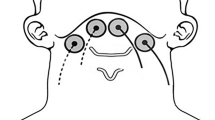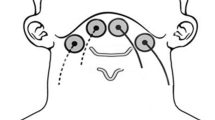Abstract
Limited research in swallowing physiology has suggested that the most common existing transcutaneous electrical stimulation (TES) protocol (VitalStim) may not penetrate to layers of tissue to affect deep swallowing muscles. TES amplitude is the primary parameter that determines the depth of electrical current penetration (DECP). Preliminary work suggests that replacing a long-pulse duration with a short-pulse duration can increase maximum amplitude tolerance (MAT) within subjects’ comfort level. Increasing MAT may indicate a higher DECP. The current study evaluates this premise in reference to the effects of varying pulse duration on lingual-palatal pressure during swallowing. Thirty healthy older adults (60–70 years of age) participated in this study. Each subject swallowed three trials of 10 mL pudding under three TES conditions: no stimulation, short-pulse duration, and long-pulse duration. TES was delivered using two pairs of surface electrodes on the submental muscles. MAT and perceived discomfort levels were identified separately for short and long-pulse TES conditions. Lingual-palatal peak pressure, pressure integral, and pressure duration were measured under each condition. Two-way repeated measures ANOVAs were conducted to identify within subject effects of TES condition and tongue bulb location. Lingual-palatal pressure and pressure integral were significantly reduced in the short-pulse duration condition. MAT was significantly higher in the short-pulse duration versus the long-pulse duration condition. Furthermore, MAT was significantly correlated with lingual-palatal pressure. Changing pulse duration had no significant impact on tongue pressure duration. Results suggest that a short-pulse duration may penetrate deeper into muscles involved in swallowing. The specific impact is reflected in a reduced upward pressure of the tongue on the palate during swallowing. This ‘restrictive’ effect of TES on tongue pressure may have the potential to be used during a resistive exercise paradigm for tongue elevation during swallowing.





Similar content being viewed by others
References
Bennett JW, van Lieshout PH, Steele CM. Tongue control for speech and swallowing in healthy younger and older subjects. Int J Orofac Myol. 2007;33:5–18.
Sakaue K, Fukui T, Sasakura C, Hori K, Ono T, Saito I. Tongue pressure production during swallowing in patients with mandibular prognathism. J Oral Rehabil. 2016;43(5):348–55. https://doi.org/10.1111/joor.12379.
Bourdiol P, Mishellany-Dutour A, Peyron MA, Woda A. Tongue-mandible coupling movements during saliva swallowing. J Oral Rehabil. 2014;41(3):199–205. https://doi.org/10.1111/joor.12135.
Steele C, Sasse C, Bressmann T. Tongue-pressure and hyoid movement timing in healthy liquid swallowing. Int J Lang Commun Disord. 2012;47(1):77–83. https://doi.org/10.1111/j.1460-6984.2011.00082.x.
Park JS, Oh DH, Chang M. Comparison of maximal tongue strength and tongue strength used during swallowing in relation to age in healthy adults. J Phys Therapy Sci. 2016;28(2):442–5. https://doi.org/10.1589/jpts.28.442.
Maeda K, Wakabayashi H, Shamoto H. Associations between tongue strength and swallowing difficulty in the older adults receiving long-term care. Clin Nutr. 2016;35(3):772–3. https://doi.org/10.1016/j.clnu.2016.01.025.
Yoshida M, Kikutani T, Tsuga K, Utanohara Y, Hayashi R, Akagawa Y. Decreased tongue pressure reflects symptom of dysphagia. Dysphagia. 2006;21(1):61–5. https://doi.org/10.1007/s00455-005-9011-6.
Stierwalt JA, Youmans SR. Tongue measures in individuals with normal and impaired swallowing. Am J Speech Lang Pathol. 2007;16(2):148–56. https://doi.org/10.1044/1058-0360(2007/019).
Namasivayam AM, Steele CM, Keller H. The effect of tongue strength on meal consumption in long term care. Clin Nutr. 2015. https://doi.org/10.1016/j.clnu.2015.08.001.
Robin DA, Goel A, Somodi LB, Luschei ES. Tongue strength and endurance: relation to highly skilled movements. J Speech Hear Res. 1992;35(6):1239–45.
Lazarus CL, Husaini H, Falciglia D, DeLacure M, Branski RC, Kraus D, Lee N, Ho M, Ganz C, Smith B, Sanfilippo N. Effects of exercise on swallowing and tongue strength in patients with oral and oropharyngeal cancer treated with primary radiotherapy with or without chemotherapy. Int J Oral Maxillofac Surg. 2014;43(5):523–30. https://doi.org/10.1016/j.ijom.2013.10.023.
Malandraki GA, Kaufman A, Hind J, Ennis S, Gangnon R, Waclawik A, Robbins J. The effects of lingual intervention in a patient with inclusion body myositis and Sjogren’s syndrome: a longitudinal case study. Arch Phys Med Rehabil. 2012;93(8):1469–75. https://doi.org/10.1016/j.apmr.2012.02.010.
Robbins J, Gangnon RE, Theis SM, Kays SA, Hewitt AL, Hind JA. The effects of lingual exercise on swallowing in older adults. J Am Geriatr Soc. 2005;53(9):1483–9. https://doi.org/10.1111/j.1532-5415.2005.53467.x.
Robbins J, Kays SA, Gangnon RE, Hind JA, Hewitt AL, Gentry LR, Taylor AJ. The effects of lingual exercise in stroke patients with dysphagia. Arch Phys Med Rehabil. 2007;88(2):150–8. https://doi.org/10.1016/j.apmr.2006.11.002.
Lazarus C, Logemann JA, Pauloski BR, Rademaker AW, Helenowski IB, Vonesh EF, MacCracken E, Mittal BB, Vokes EE, Haraf DJ. Effects of radiotherapy woth or without chemotherapy on tongue strength and swallowing in patients with oral cancer. Head Neck J Sci Spec. 2007;29(7):632–7. https://doi.org/10.1002/hed.20577.
Steele CM, Bailey GL, Polacco RE, Hori SF, Molfenter SM, Oshalla M, Yeates EM. Outcomes of tongue-pressure strength and accuracy training for dysphagia following acquired brain injury. Int J Speech Lang Pathol. 2013;15(5):492–502. https://doi.org/10.3109/17549507.2012.752864.
Carnaby GD, Harenberg L. What is “usual care” in dysphagia rehabilitation: a survey of USA dysphagia practice patterns. Dysphagia. 2013;28(4):567–74. https://doi.org/10.1007/s00455-013-9467-8.
Chen YW, Chang KH, Chen HC, Liang WM, Wang YH, Lin YN. The effects of surface neuromuscular electrical stimulation on post-stroke dysphagia: a systemic review and meta-analysis. Clin Rehabil. 2015;30(1):24–35. https://doi.org/10.1177/0269215515571681.
Ludlow CL, Humbert I, Saxon K, Poletto C, Sonies B, Crujido L. Effects of surface electrical stimulation both at rest and during swallowing in chronic pharyngeal dysphagia. Dysphagia. 2007;22(1):1–10. https://doi.org/10.1007/s00455-006-9029-4.
Lee HY, Hong JS, Lee KC, Shin YK, Cho SR. Changes in hyolaryngeal movement and swallowing function after neuromuscular electrical stimulation in patients with Dysphagia. Ann Rehabil Med. 2015;39(2):199–209. https://doi.org/10.5535/arm.2015.39.2.199.
Humbert IA, Poletto CJ, Saxon KG, Kearney PR, Crujido L, Wright-Harp W, Payne J, Jeffries N, Sonies BC, Ludlow CL. The effect of surface electrical stimulation on hyolaryngeal movement in normal individuals at rest and during swallowing. J Appl Physiol. 2006;101(6):1657–63. https://doi.org/10.1152/japplphysiol.00348.2006.
McClung JR, Goldberg SJ. Functional anatomy of the hypoglossal innervated muscles of the rat tongue: a model for elongation and protrusion of the mammalian tongue. Anat Rec. 2000;260(4):378–86.
Berretin-Felix G, Sia I, Barikroo A, Carnaby GD, Crary MA. Immediate effects of transcutaneous electrical stimulation on physiological swallowing effort in older versus young adults. Gerodontology. 2016;33(3):348–55. https://doi.org/10.1111/ger.12166.
Barikroo A, Berretin-Felix G, Carnaby G, Crary M. Effect of transcutaneous electrical stimulation amplitude on timing of swallow pressure peaks between healthy young and older adults. Gerodontology. 2017;34(1):24–32. https://doi.org/10.1111/ger.12221.
Denegar CR, Saliba E, Saliba SF. Therapeutic Modalities for Musculoskeletal Injuries. 4th ed. Illinois: Human Kinetics; 2016.
Bracciano AG. Physical Agent Modalities: Theory and Application for the Occupational Therapist. New Jersey: SLACK Incorporated; 2008.
Petrofsky J. The effect of the subcutaneous fat on the transfer of current through skin and into muscle. Med Eng Phys. 2008;30(9):1168–76. https://doi.org/10.1016/j.medengphy.2008.02.009.
Petrofsky J, Laymon M, Prowse M, Gunda S, Batt J. The transfer of current through skin and muscle during electrical stimulation with sine, square, Russian and interferential waveforms. J Med Eng Technol. 2009;33(2):170–81. https://doi.org/10.1080/03091900802054580.
Gorgey AS, Mahoney E, Kendall T, Dudley GA. Effects of neuromuscular electrical stimulation parameters on specific tension. Eur J Appl Physiol. 2006;97(6):737–44. https://doi.org/10.1007/s00421-006-0232-7.
Clair-Auger JM, Collins DF, Dewald JP. The effects of wide pulse neuromuscular electrical stimulation on elbow flexion torque in individuals with chronic hemiparetic stroke. Clin Neurophysiol. 2012;123(11):2247–55. https://doi.org/10.1016/j.clinph.2012.04.024.
Lagerquist O, Collins DF. Influence of stimulus pulse width on M-waves, H-reflexes, and torque during tetanic low-intensity neuromuscular stimulation. Muscle Nerve. 2010;42(6):886–93. https://doi.org/10.1002/mus.21762.
Laufer Y, Elboim M. Effect of burst frequency and duration of kilohertz-frequency alternating currents and of low-frequency pulsed currents on strength of contraction, muscle fatigue, and perceived discomfort. Phys Ther. 2008;88(10):1167–76. https://doi.org/10.2522/ptj.20080001.
Mesin L, Merlo E, Merletti R, Orizio C. Investigation of motor unit recruitment during stimulated contractions of tibialis anterior muscle. J Electromyogr Kinesiol. 2010;20(4):580–9. https://doi.org/10.1016/j.jelekin.2009.11.008.
Reilly JP, Antoni H. Electrical stimulation and electropathology. Cambridge: Cambridge University Press; 1992.
Scott WB, Causey JB, Marshall TL. Comparison of maximum tolerated muscle torques produced by 2 pulse durations. Phys Ther. 2009;89(8):851–7. https://doi.org/10.2522/ptj.20080151.
Doucet BM, Lam A, Griffin L. Neuromuscular electrical stimulation for skeletal muscle function. Yale J Biol Med. 2012;85(2):201–15.
Barikroo A, Carnaby G, Bolser D, Rozensky R, Crary M. Transcutaneous electrical stimulation on the anterior neck region: the impact of pulse duration and frequency on maximum amplitude tolerance and perceived discomfort. J Oral Rehabil. 2018. https://doi.org/10.1111/joor.12625.
Crary MA, Mann GD, Groher ME. Initial psychometric assessment of a functional oral intake scale for dysphagia in stroke patients. Arch Phys Med Rehabil. 2005;86(8):1516–20. https://doi.org/10.1016/j.apmr.2004.11.049.
Yoshikawa M, Yoshida M, Tsuga K, Akagawa Y, Groher ME. Comparison of three types of tongue pressure measurement devices. Dysphagia. 2011;26(3):232–7. https://doi.org/10.1007/s00455-010-9291-3.
Carlsson AM. Assessment of chronic pain. I. Aspects of the reliability and validity of the visual analogue scale. Pain. 1983;16(1):87–101.
Faul F, Erdfelder E, Lang AG, Buchner A. G*Power 3: a flexible statistical power analysis program for the social, behavioral, and biomedical sciences. Behav Res Methods. 2007;39(2):175–91.
Adams GR, Harris RT, Woodard D, Dudley GA. Mapping of electrical muscle stimulation using MRI. J Appl Physiol. 1993;74(2):532–7.
Alon G, Allin J, Inbar GF. Optimization of pulse duration and pulse charge during transcutaneous electrical nerve stimulation. Aust J Physiother. 1983;29(6):195–201. https://doi.org/10.1016/S0004-9514(14)60670-X.
Mendell LM. The size principle: a rule describing the recruitment of motoneurons. J Neurophysiol. 2005;93(6):3024–6. https://doi.org/10.1152/classicessays.00025.2005.
Kesar T, Chou LW, Binder-Macleod SA. Effects of stimulation frequency versus pulse duration modulation on muscle fatigue. J Electromyogr Kinesiol. 2008;18(4):662–71. https://doi.org/10.1016/j.jelekin.2007.01.001.
Gorgey AS, Dudley GA. The role of pulse duration and stimulation duration in maximizing the normalized torque during neuromuscular electrical stimulation. J Orthop Sports Phys Therapy. 2008;38(8):508–16. https://doi.org/10.2519/jospt.2008.2734.
Steele CM, Bailey GL, Molfenter SM. Tongue pressure modulation during swallowing: water versus nectar-thick liquids. J Speech Lang Hear Res. 2010;53(2):273–83. https://doi.org/10.1044/1092-4388(2009/09-0076).
Perlman AL, Schultz JG, VanDaele DJ. Effects of age, gender, bolus volume, and bolus viscosity on oropharyngeal pressure during swallowing. J Appl Physiol. 1993;75(1):33–7.
Blissett A, Prinz JF, Wulfert F, Taylor AJ, Hort J. Effect of bolus size on chewing, swallowing, oral soft tissue and tongue movement. J Oral Rehabil. 2007;34(8):572–82. https://doi.org/10.1111/j.1365-2842.2007.01756.x.
Lan Y, Ohkubo M, Berretin-Felix G, Sia I, Carnaby-Mann GD, Crary MA. Normalization of temporal aspects of swallowing physiology after the McNeill dysphagia therapy program. Ann Otol Rhinol Laryngol. 2012;121(8):525–32.
Humbert IA, Christopherson H, Lokhande A. Surface electrical stimulation perturbation context determines the presence of error reduction in swallowing hyolaryngeal kinematics. Am J Speech-Lang Pathol. 2015;24(1):72–80. https://doi.org/10.1044/2014_AJSLP-14-0045.
Hashimoto M, Igari K, Hanawa S, Ito A, Takahashi A, Ishida N, Koyama S, Ono T, Sasaki K. Tongue pressure during swallowing in adults with down syndrome and its relationship with palatal morphology. Dysphagia. 2014;29(4):509–18. https://doi.org/10.1007/s00455-014-9538-5.
Cheng CF, Peng CL, Chiou HY, Tsai CY. Dentofacial morphology and tongue function during swallowing. Am J Orthod Dentofac. 2002;122(5):491–9. https://doi.org/10.1067/mod.2002.128865.
Park JW, Oh JC, Lee HJ, Park SJ, Yoon TS, Kwon BS. Effortful swallowing training coupled with electrical stimulation leads to an increase in hyoid elevation during swallowing. Dysphagia. 2009;24(3):296–301. https://doi.org/10.1007/s00455-008-9205-9.
Funding
This study was partially supported by the National Center For Advancing Translational Sciences of the National Institutes of Health under Award Number UL1TR001427. The content is solely the responsibility of the authors and does not necessarily represent the official views of the National Institutes of Health.
Author information
Authors and Affiliations
Corresponding author
Ethics declarations
Conflict of interest
The authors declare that they have no conflict of interest.
Ethical Approval
All procedures performed in studies involving human participants were in accordance with the ethical standards of the institutional and/or national research committee and with the 1964 Helsinki declaration and its later amendments or comparable ethical standards.
Informed Consent
Informed consent was obtained from all individual participants included in the study.
Additional information
Publisher's Note
Springer Nature remains neutral with regard to jurisdictional claims in published maps and institutional affiliations.
Rights and permissions
About this article
Cite this article
Barikroo, A., Hegland, K., Carnaby, G. et al. The Effects of Electrical Stimulation Pulse Duration on Lingual Palatal Pressure Measures During Swallowing in Healthy Older Adults. Dysphagia 34, 529–539 (2019). https://doi.org/10.1007/s00455-019-09991-y
Received:
Accepted:
Published:
Issue Date:
DOI: https://doi.org/10.1007/s00455-019-09991-y




